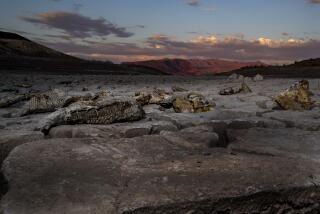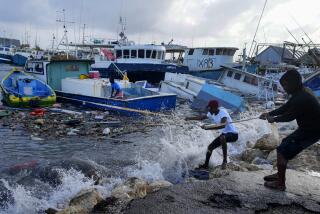Some climate scientists, in a shift, link weather to global warming
The worst drought in half a century has plagued two-thirds of the nation, devastating farms and stoking wildfires that scorched almost 9 million acres this year. Withering heat blanketed the East Coast and Midwest, killing scores of people and making July the hottest month ever recorded in the U.S. And in the Arctic this summer, polar snow and ice melted away to the smallest size ever observed by man.
Extreme events like drought, heat waves, intense rainfall, flooding and fires have prompted many people to reconsider the connection between the weather and the changing climate. Now, a handful of scientists are among them.
In a break with the mainstream scientific consensus, a few prominent climate scientists now argue that there have been enough episodes of drought and intense heat in the last 10 years to establish a statistical pattern of extreme weather due to global warming.
One of those scientists is NASA climatologist James Hansen. In a study published last month in the Proceedings of the National Academy of Sciences, he noted that dramatic events like droughts and heat waves affected just 1% of Earth’s surface between 1950 and 1980; in the last 30 years, that figure has jumped to 10%.
“We can state, with a high degree of confidence, that extreme anomalies ... were a consequence of global warming because their likelihood in the absence of global warming was exceedingly small,” he and his colleagues wrote.
Hansen isn’t the only one who suspects that the signature of climate change can be seen in recent weather trends.
Around the world, “the incidence of drought is consistent with what the climate models are predicting,” said John Seinfeld, an atmospheric researcher at Caltech. “It certainly doesn’t appear to be out of line to conclude that this last summer could be statistically attributed to global warming.”
In the U.S., the summer ranked as the third-hottest in the nation’s history.
Among laypeople, the perception that extreme weather is getting worse — and that it’s linked to climate change — is increasingly taking hold.
Nearly 75% of Americans now say global warming is affecting the weather in the U.S., according to a poll released this week by scientists at Yale University. The poll found that about 60% of Americans reported experiencing an extreme heat wave or drought this year, while an equal percentage said weather had worsened over the last several years. A companion poll reported earlier this year that 8 in 10 Americans had personally experienced at least one extreme weather event in the last year, and more than one-third said they had suffered as a result.
Jerry Lubell narrowly missed being one of them this summer, as a 100-foot wall of flames approached his Colorado Springs, Colo., home. The fire spared his house but left him shaken.
“It has me thinking,” said the retired nuclear engineer, a longtime skeptic of the idea that human activity is behind global warming. “I haven’t changed any fundamental opinions yet, but I might.”
Climate scientists overwhelmingly agree that the planet is getting hotter and that mankind’s use of fossil fuels is largely responsible.
When fossil fuels are burned, carbon dioxide is produced and traps heat within the atmosphere. The more that’s added, the hotter it gets. It’s not the only greenhouse gas, but it’s the one many scientists focus on because it stays in the atmosphere for hundreds or thousands of years.
The average global temperature has risen by 1.6 degrees Fahrenheit over the last century, a period that gave rise to mass-produced automobiles and commercial aviation, among other developments. Altogether, modernization has led to an 800% increase in global fossil fuel consumption since 1900, with a corresponding jump in emissions of heat-trapping greenhouse gases.
As the temperature rises, evaporation increases and draws more water from soil. Experts predict that moist areas of the planet will become wetter, while dry areas will become drier.
Still, most climatologists say science can draw no clear link between climate change and specific weather events like hurricanes, tornadoes, droughts or heat waves.
“We’re living in a warmer world,” said William Patzert, a climatologist at NASA’s Jet Propulsion Laboratory in La Cañada Flintridge. “But to say that the hurricanes are more intense, that the tornadoes are more frequent, that the droughts are longer, that the floods are more serious, the forest fires are larger and more frequent — I’m not there.”
“Sometimes it’s hotter, sometimes it’s colder, sometimes it’s drier, sometimes it’s wetter,” added Tapio Schneider, an environmental engineering professor at Caltech. “Not all of that is climate change.”
Asking whether the summer’s record heat was evidence of global warming is like asking whether steroids helped a baseball player hit a home run in the bottom of the ninth inning during the World Series, said Anthony Leiserowitz, an environmental scientist with the Yale Project on Climate Change. If the player was able to hit home runs before he took steroids, it would be impossible to know whether any particular home run could be traced directly to performance-enhancing drugs. However, at the end of the season, it would be clear that the player hit home runs with greater frequency.
“That’s what we have here,” Leiserowitz said. “We’ve juiced the world’s climate system by putting these gases in the atmosphere.”
Looking ahead, some climate scientists are predicting more extreme weather events in North America and Europe this winter — and those following — thanks to the record amount of Arctic ice melting over the summer.
Last month, researchers announced that Arctic sea ice had dwindled to the smallest size ever observed by man. At about 1 million square miles, the ice mass was less than half the size it was at its smallest point 30 years ago, when satellites and submarines first began taking detailed measurements.
The loss of Arctic ice has several effects. Ice reflects heat and solar energy back into space. With less ice cover, that heat energy is instead absorbed by the ocean, which warms and melts more ice.
The heating of polar seawater has also reduced the temperature difference between the Arctic and Earth’s middle latitudes. That slows down the jet stream, the river of air that flows from west to east high above Earth’s surface. The jet stream, in turn, controls the formation and movement of storm systems. The result is that weather conditions in an area persist for longer periods, according to a study published this year in Geophysical Research Letters.
“If you have a rainy pattern and it hangs around for a long time, then that becomes a situation that could lead to flooding,” said Jennifer Francis, a researcher at the Institute of Marine and Coastal Sciences at Rutgers University.
Whether that happens this winter remains to be seen. However, forecasters are already predicting continued drought conditions in the northern Plains and upper Midwest, while the Gulf Coast and Southeast are in for a wet winter.







